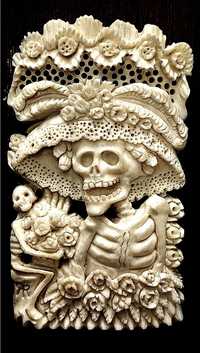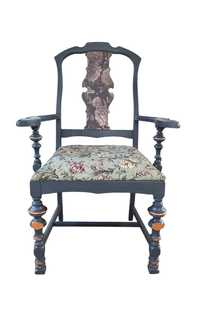The Estanquillo showcases the greatness of the miniatures by artisan Roberto Ruiz

The Estanquillo showcases the greatness of the miniatures by artisan Roberto Ruiz
Merry MacMasters
La Jornada Newspaper, Thursday, July 17, 2025, p. 5
The writer and journalist Carlos Monsiváis (1938-2010) was a passionate collector of the miniature sculptures of Oaxacan artisan Roberto Ruiz (1928-2008). Over the years, he acquired hundreds of these carved and sculpted bone objects, depicting a variety of themes, from skeletons, catrinas, archangels, and devils to religious images, national heroes, and scenes from everyday life inspired by the artist's homeland.
He even wrote a book about the 1988 recipient of the National Prize for Sciences and Arts in the area of Arts and Traditions. For Monsiváis, Ruiz's obsession
with skulls "stems organically from his search for essential forms, for rigorous presentations of the popular and the traditional. Displaying his sensitivity in variegated ensembles (where the forced promiscuity of the figures engenders unexpected couplings, lines of sensuality that birth offers), he also uses the most orthodox motifs, the landscapes of costumbrismo, the amorous love of even-numbered couples
. While the themes vary, the constant is the attitude of maestro Ruiz, who deeply immerses himself in each piece and never compromises in intensity or imaginative power."
Apparently, the only teacher Ruiz recognized was José Guadalupe Posada.
In 2008, the Museo del Estanquillo (Carlos Monsiváis Collections Museum) dedicated an exhibition to him. Now, the museum returns to the theme with the presentation of Roberto Ruiz: Giant of the Miniature , featuring more than 600 pieces, all collected by the writer. The Estanquillo Museum houses the largest collection of miniature sculptures by the man who developed his body of work in Ciudad Nezahualcóyotl. The works span from 1960 to 1990.
Born on March 2, 1928, in Miahuatlán, Ruiz studied through the second year of primary school. At the age of 6, he began playing with clay, which he collected from the floor of a pottery workshop across the street from his house, to mold figurines. At 9, he turned to wood. When he was sent to shepherding, he amused himself by making wooden figures from what he saw in the fields, using sharp tools, a machete, or a knife.
Family pressures forced him to work, and in the kitchen of a bakery, he discovered his future career, turning bread dough into figures. At school, instead of doing what his teacher suggested, he filled his notebook with drawings. He never stopped making his figurines, budding miniatures of dancers, Tehuanas, and nativity scenes.

▲ La Catrina , a bone sculpture by Roberto Ruiz. Photo taken from the Museo del Estanquillo Facebook page.
Around 1943, the teenager traveled to the city of Oaxaca to sell his creations. At some point, he realized that his sensitivity, manual skill, and the tools he had weren't enough to make more elaborate works. He then toyed with the idea of attending school to better learn what he did in a rustic way, but such a school didn't exist.
Faced with his poor life prospects, Ruiz moved to Mexico City in search of his dream school. He settled in the Las Palmas neighborhood of Ciudad Nezahualcóyotl, married, and gradually developed and explored his own imagination. With complete mastery of the tools and instruments common in dental workshops, he began to make new miniatures more in tune with his interests. He distanced himself from the stereotypes and typicalities
so in demand in artisan shops and opted for figures of death that had always haunted his imagination.
Around 1957, the new themes and motifs attracted the attention of the owner of the Víctor craft store and several private individuals, including the directors of the Museum of Popular Arts and Industries, who proposed an exhibition of his miniatures. In the late 1960s, the museum's directors encouraged him to create miniatures with specific themes. This led to an increase in his income, allowing him to stop making plastic molds, which he used to support his family.
Queen Elizabeth II cameo
Of his carved works, 17 were part of an exhibition at the British Museum in 1981. Such was their success that Queen Elizabeth II posed for Ruiz to make an ivory cameo of her image. The piece was stored with the crown jewels, and the 17 pieces were moved to Buckingham Palace, where they were displayed for 28 years.
Ruiz's sculptures stand out not only for the precision of their carving, but also for the stories each one holds.
Roberto Ruiz: Giant of the Miniature will be inaugurated on Saturday at 12 noon at the Museo del Estanquillo Carlos Monsiváis Collections (Isabel la Católica 26, Historic Center, Mexico City).
The symbolic, political, and religious power of chairs is revealed in Oaxaca.
Daniel López Aguilar
La Jornada Newspaper, Thursday, July 17, 2025, p. 5
Among the objects that are part of everyday life, few hold as much memory as a chair. They are silent witnesses that bear the weight of time, conversations, and silences.
This symbolic charge is the focus of SillArte , an exhibition of 13 pieces created by the creative duo Max Sanz and his wife, Guadalupe Pérez Morales. The exhibition is being held at the Hotel Casa Cantera in downtown Oaxaca.
They have a symbolic, political and religious power that has always accompanied them
, Sanz explained in an interview with La Jornada .
The choice of chair also has a practical aspect. Buying one is very simple. We wanted it to remain functional and decorative at the same time.
Each work combines techniques that emphasize its uniqueness: gold leaf, liquid glass, PVC tapestry, liquid bronze, toning agents, Judean bitumen, and crackle. It's not just about beautifying them, but also about highlighting the history of those who designed, used, and preserved them.
The project was born almost by chance after several conversations with a workshop that rescues antique pieces brought from the United States. One day, we told them we had refurbished a family object, and that's where the idea of displaying the pieces came from
, the Oaxacan artist recalled.
The complicity between Sanz (Natividad, Oaxaca, 1992) and Pérez Morales is another cornerstone of the project. "Two heads are better than one. We share a passion for decoration, which we studied together
," he commented.
"Within the duo, I'm more in charge of the technical and visual aspects, while Guadalupe brings a more sensitive perspective that gives character to each work. We understand each other because we speak the same creative language, although each of us has our own style."

▲ Piece renovated by Max Sanz and Guadalupe Pérez Morales and included in the SillArte exhibition. Photo courtesy of Sanz
Rather than erasing the traces of the past, we sought to keep them alive. We wanted to recover the moment in which they were created, the designs conceived for the fashion and comfort of that era
, he emphasized.
The montage invites you to awaken memories: a family room, your grandparents' house, a movie scene.
These pieces of furniture have always been associated with those who valued detail and quality. Rather than repeating baroque or classical tapestry, we transformed them with contemporary colors and textures
, the artist added.
Restoring and transforming old furniture helped reduce tree felling and prevented it from ending up as trash that takes centuries to decompose, she explained. It was also a sensible economic decision: it's better to invest in something that lasts rather than something disposable
.
For Sanz, the Oaxacan setting gave meaning and nuance to the project. "Here, art is felt in the looms, the clay, the alebrijes... We reclaimed that identity to apply it to pieces that continue to be part of daily life."
We want the public to remember that behind every creation there was someone who thought it through, chose materials and shapes, and who still has something to say today. Chairs hold more than bodies: they hold memories, glances, and even what's left unsaid
, he concluded.
With free admission, SillArte can be visited at the Hotel Casa Cantera (Privada de Reforma 103, Centro neighborhood, Oaxaca).
jornada

